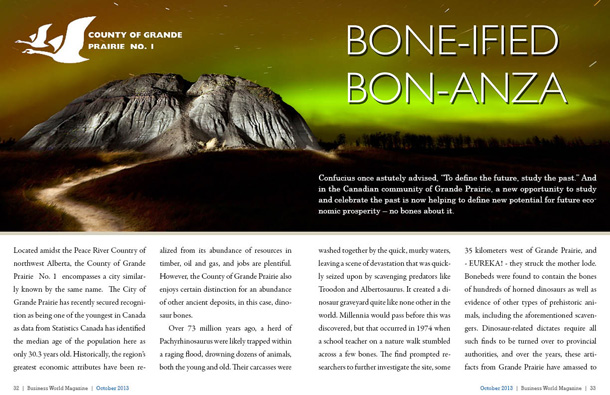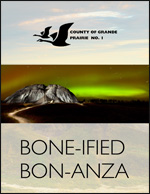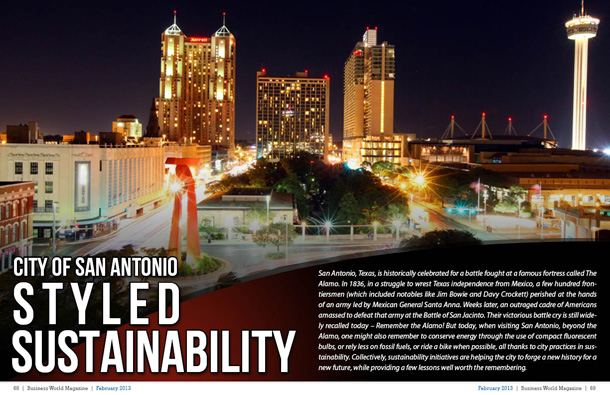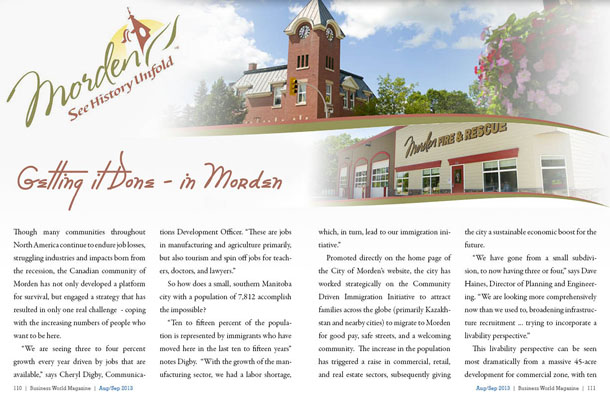
Bone-ified Bon-anza

Confucius once astutely advised, “To define the future, study the past.†And in the Canadian community of Grande Prairie, a new opportunity to study and celebrate the past is now helping to define new potential for future economic prosperity – no bones about it.
Located amidst the Peace River Country of northwest Alberta, the County of Grande Prairie  No. 1  encompasses a city similarly known by the same name. The City of Grande Prairie has recently secured recognition as being one of the youngest in Canada as data from Statistics Canada has identified the median age of the population here as only 30.3 years old. Historically, the region’s greatest economic attributes have been realized from its abundance of resources in timber, oil and gas, and jobs are plentiful. However, the County of Grande Prairie also enjoys certain distinction for an abundance of other ancient deposits, in this case, dinosaur bones.
Over 73 million years ago, a herd of Pachyrhinosaurus were likely trapped within a raging flood, drowning dozens of animals, both the young and old. Their carcasses were washed together by the quick, murky waters, leaving a scene of devastation that was quickly seized upon by scavenging predators like Troodon and Albertosaurus. It created a dinosaur graveyard quite like none other in the world. Millennia would pass before this was discovered, but that occurred in 1974 when a school teacher on a nature walk stumbled across a few bones. The find prompted researchers to further investigate the site, some 35 kilometers west of Grande Prairie, and – EUREKA! – they struck the mother lode. Bonebeds were found to contain the bones of hundreds of horned dinosaurs as well as evidence of other types of prehistoric animals, including the aforementioned scavengers. Dinosaur-related dictates require all such finds to be turned over to provincial authorities, and over the years, these artifacts from Grande Prairie have amassed to enhance exhibits at institutions such as the Royal Tyrrell Museum near Drumheller or have complemented palaeontology studies at the University of Alberta. Some years ago, the folks in Grande Prairie began to speculate that they might be missing out on the economic and educational advantages offered by this site.
Triassic Triumph
Brian Brake is the Executive Director of the Pipestone Creek Dinosaur Initiative. Brake explains that some ten years ago, a consortium came together to determine how the region could best benefit from its bounty in dinosaur bones. Those efforts have since led to the ground breaking for what is anticipated to become one of the most significant of museums and research centers dedicated to dinosaurs. Named in honor of a Canadian researcher respected as one of the world’s leading palaeontologists, the Philip J. Currie Dinosaur Museum will be located just off of Highway 43 in the town of Wembley. When completed next year, the 41,000 square-foot facility will include a gallery with exhibitions of large skeletons, a wing devoted to the region’s resources in oil and gas, a tech-infused theatre named in honor of actor Dan Aykroyd, two educational classrooms and a palaeontology lab that specifically caters to the needs of working scientists. “We’ll create the most significant cultural facility in northwest Alberta,†says Brake, adding that other elements will include a gift shop and restaurant.
Designed by Edmonton-based Architecture ATB and Toronto-based Teeple Architects (and built by PCL Construction), Brake says the site is being developed consistent with LEED standards and will be comprised by state-of-the-art technology as well as the most advanced of electrical and mechanical systems. The project reflects $35 million in investments. Thus far, $12.6 million has been contributed by the County of Grande Prairie, $10 million has been provided by the Alberta Government and the City of Grande Prairie has pledged $3.5 million. Brake says additional support has come from the professionals in the energy sector and a host of community benefactors. In preparation for the education programs sponsored by the museum, interactive, curriculum-connected programs have already been trialed among 7,000 students, and Brake says he has been excited by the “phenomenal†response which has come from not only educational leaders, but also families, government officials and the regional business community.
That excitement isn’t simply a reflection of the educational or entertainment values the museum will house, but what it will offer in terms of enhancing the local economy. As for the potential with that, Brake points to tourism studies that indicate Alberta’s Royal Tyrrell Museum helps drive hotel lodging rates equivalent to 240,000 room nights per year. That museum, along with the famed fossil beds displayed at Dinosaur Provincial Park, annually attract some 400,000 visitors from across Canada and throughout the world. Brake says other studies have shown that whenever a world class museum and research center is developed at a site, it goes on to help spur the creation of more than 11 other support-related businesses. In fact, several new businesses have already expressed interest in locating to the Wembley area, and the museum isn’t even finished.
According to Herb Pfau of the County of Grande Prairie’s Public Works Department, “There’s a lot of excitement here, right now, generated by the museum and the other things that will come soon.†As for the coming soon, Pfau notes that a new regional 64,000 m2 hospital, which is expected to attract more medical professionals to the community, is under construction in Grande Prairie. It is anticipated that the hospital will be completed by 2017. Pfau’s department is also busy enhancing local area roadways, and he says that Alberta Transportation will soon result in the twinning of Highway 43 from Edmonton to Grande Prairie, spanning over 400 kilometers.
The flood that may have led to the dinosaur deposits, which is now fueling the creation of a world class museum and research center, is envisioned to prompt another flood of business and tourism development.
Â
 For more information, please visit their website at:   County of Grande Prairie  No. 1








